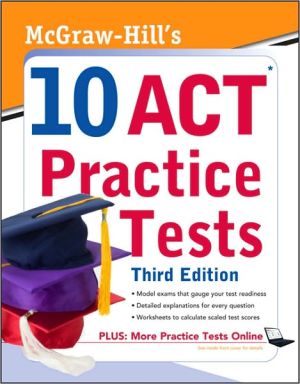CliffsTestPrep ACT
The CliffsTestPrep series offers full-length practice exams that simulate the real tests; proven test-taking strategies to increase your chances at doing well; and thorough review exercises to help fill in any knowledge gaps.\ CliffsTestPrep ACT can help you assess your interests and skills, plan your career, get a scholoarship, and get into a college of your choice. Understanding and practicing test-taking strategies can help a great deal. Subject matter review is particularly useful for the...
Search in google:
Your complete guide to a higher score on the ACTWhy CliffsTestPrep Guides?Go with the name you know and trustGet the information you need—fast!Written by test prep specialistsAbout the contents:IntroductionEffective test-taking strategiesComprehensive exam overviewAnswers to your questions about the testAnswers to your questions about the new Writing TestPart I: Analysis of Exam AreasImportant approaches and samples for each content area: English, Mathematics, Reading, Science Reasoning, and WritingAnalysis of directions and content area breakdownsPart II: Four Full-Length Practice TestsComplete answers and explanations for each testAnalysis/Tally sheets for problems missedSpecial section on the new Writing Test, including effective writing techniquesTest Prep Essentials from the Experts at CliffsNotes®
CliffsTestPrep ACT\ \ By Jerry Bobrow \ John Wiley & Sons\ ISBN: 0-7645-9935-6 \ \ \ Chapter One\ INTRODUCTION TO THE ENGLISH TEST \ The English Test is 45 minutes long and contains 75 multiple-choice questions.\ Ability Tested\ The English Test tests your ability to recognize and correct errors in standard written English. It tests your knowledge of grammar, punctuation, sentence structure, and rhetoric. It is not a test of spelling, vocabulary, or recall of grammar rules.\ The test covers five or six prose passages of differing styles and content, upon which the multiple-choice questions are based.\ Basic Skills Necessary\ The basic skills necessary to perform well on the English Test include the six elements of effective writing.\ Usage/Mechanics\ * punctuation, with an emphasis on punctuation that influences meaning, such as that which avoids ambiguity or identifies an appositive\ * basic grammar and usage, such as agreement, case, verb form, and idiomatic usage\ * sentence structure, including correct subordination, parallelism, and placement of modifiers\ Rhetorical Skills\ * strategy, including questions about the audience, purpose, and effectiveness of prose\ * organization, including questions about the order, unity, and coherence of a passage\ * style, including questions about diction, imagery, freedom from ambiguity, and economy in writing\ Directions\ In the left-hand column, you will find passages in a "spread-out" format with various words and phrases underlined and numbered. In the right-hand column, you will find a set of responses corresponding to each underlined portion. If the underlined portion is correct standard written English, is most appropriate to the style and feeling of the passage, or best makes the intended statement, mark the letter indicating "NO CHANGE." If the underlined portion is not the best choice given, choose the one that is. For these questions, consider only the underlined portions; assume that the rest of the passage is correct as written. You will also see questions concerning parts of the passage or the whole passage. Choose the response you feel is best for these questions.\ For some passages, you may also be given a box of additional directions similar to the following.\ The following paragraphs are given a number in parentheses above each one. The paragraphs may be in the most logical order, or they may not. Item ___ asks you to choose the paragraph sequence that is the most logical.\ Analysis of Directions\ 1. Make sure you understand the passage as a whole; a correct choice must be appropriate to the meaning of the passage, the author's purpose, the audience, and so forth. Read through the entire passage quickly and make sure you understand it before dealing with the underlined portions.\ 2. You're looking for errors in standard written English, the kind of English used in most textbooks. Don't evaluate a sentence in terms of the spoken English we all use.\ 3. When deciding whether an underlined portion is correct or not, assume that all parts that aren't underlined are correct.\ 4. Several alternatives to an underlined portion may be partially correct. You are to pick the one that fits the meaning of the sentence and is grammatically and structurally sound.\ 5. You may also be given some general questions about the rhetoric (organization, style, purpose) of the passage.\ Suggested Approach with Samples\ Some of the types of errors you'll encounter are errors in\ * punctuation * grammar * sentence structure * logic and organization * idiom\ A short discussion of each of these types of errors using simple questions will give you a basic understanding of the structure of the English Test. Remember, though, that there are many other types of errors, which are discussed in the explanations for the practice test questions.\ Punctuation errors. Suspect a punctuation error when a period, comma, semicolon, colon, or dash is part of the underlined portion. Note, however, that simply because a punctuation mark is underlined doesn't mean that it is necessarily part of the error. (If the underlined portion is, for example, at the end of a sentence, the test regularly underlines the period, whether it is involved in the error or not.)\ 1. At sunrise, we assembled the climbing, gear that we had hidden the night before.\ A. NO CHANGE\ B. the climbing gear that we had hidden\ C. the climbing; gear that we had hidden\ D. the climbing-gear that we had hidden\ The comma following climbing makes the sentence unintelligible; you can't assemble a climbing, but you can assemble climbing gear. So removing the comma altogether, choice B., restores meaning to the sentence.\ Grammar errors. A grammar error requires that the form of the work be changed. Common grammar errors involve incorrect pronouns or disagreement between subject and verb.\ Pronoun error.\ 2. The computer corrected oneself and continued to run the program.\ F. NO CHANGE\ G. corrects itself\ H. corrected itself\ J. corrects oneself\ Oneself may correctly refer to a person, but not to a thing. Since a computer is a thing, the correct pronoun is itself, so H. is the best choice because it supplies itself without unnecessarily changing corrected.\ Subject-Verb Agreement error.\ 3. The carton of roses and carnations were beautifully displayed in the window.\ A. NO CHANGE\ B. was\ C. weren't\ D. OMIT the underlined portion.\ The subject is singular, carton, so the verb must be singular, was instead of were. Choice B. is correct.\ Sentence Structure errors. A sentence structure error occurs when the parts of a sentence are not arranged in a logical order or when an essential part or parts have been omitted. Common sentence structure errors are faulty parallelism and dangling modifiers.\ Faulty Parallelism.\ 4. He drank, smoked, and watching TV too much.\ F. NO CHANGE\ G. to watch TV\ H. watched TV\ J. will watch TV\ Watching TV isn't parallel to (doesn't have the same form as) the other verbs with which it's listed; the correct parallel phrase is drank, smoked, and watched TV, in which each element is a verb in the past tense.\ Dangling Modifier.\ 5. A piano is for sale by a woman with walnut legs.\ A. NO CHANGE\ B. piano with walnut legs is for sale by a woman.\ C. piano is for sale with walnut legs by a woman.\ D. with walnut legs a piano is for sale.\ The sentence seems to say that the woman has walnut legs! This confusion is corrected by placing walnut legs after the word that it's meant to describe, piano, as in choice B.\ Logic and Organization errors. These errors can occur when sentences aren't arranged in logical order or when paragraphing isn't done properly.\ Incorrect Paragraphing.\ 6. The requirements for graduation are a 2.5 minimum grade-point average and two semesters of science.\ In addition to the above, a written thesis is also required.\ F. NO CHANGE\ G. (Begin new paragraph) Also a written\ H. (Begin new paragraph) However, a written\ J. (Do NOT begin new paragraph) A written\ No new paragraph is needed. The final sentence continues the main idea expressed in the initial sentence. Choice J. is correct.\ Idiom errors. Idioms are the usual way in which phrases or expressions are put together in a language. Most problems in idiom come from the improper use of prepositions (on, of, to, by, than, from, etc.).\ 7. His problems began prior of his first day at work.\ A. NO CHANGE\ B. prior to\ C. prior than\ D. on an occasion previous to\ Prior to, choice B., is the correct idiomatic usage, not prior of.\ Sample Passage\ The following is a shorter passage than appears on the exam, but it gives examples of the kinds of questions the English Test asks. Most of the questions offer alternative versions or "NO CHANGE" to underlined portions of the text. Remember, you must assume that only the underlined section can be changed and that the rest of the sentence that isn't underlined is correct.\ The ancestor of our modern microscopes are nearly four hundred years old. The early microscopes were worked and operated by lenses that, by forcing light to bend, could focus and enlarge the image of whatever object reflecting the light. By improving lensmaking, microscopes could be made to enlarge an object as much as one thousand times its original size. The word "telescope" derives from the Greek meaning "to view" and "far off"; "microscope" comes from the Greek meaning "to view" and "small."\ But-for a time microscopes could not be improved beyond that point. When the objects to be studied were smaller than the light waves that were used to see them, the objects could not be seen. The first attempt to solve this problem, in the 1920s, will use shorter light waves, such as ultraviolet. And the improvement was negligible. Waves any shorter than these could not be focused properly. The problem was unlocked and set free by using the much shorter electron waves, which can be focused by magnetic fields.\ 8. F. NO CHANGE\ G. are near H. is near\ J. is nearly\ 9. A. NO CHANGE\ B. were worked and were\ C. worked and operated by\ D. worked by\ 10. F. NO CHANGE\ G. was reflecting\ H. reflected\ J. will reflect\ 11. A. NO CHANGE\ B. By having improved lensmaking,\ C. Lensmaking having improved,\ D. With the improvement of lensmaking,\ 12. F. NO CHANGE\ G. OMIT the preceding sentence.\ H. OMIT the semicolon and the part of the sentence preceding the semicolon only.\ J. OMIT the semicolon and the part of the sentence following the semicolon only.\ 13. A. NO CHANGE\ B. But for a time: C. But, for a time,\ D. But, for a time;\ 14. What might most logically be added to the paragraph at this point?\ F. A quotation from a famous scientist\ G. A comparison of microscopes and telescopes\ H. Examples of objects too small to be seen by these instruments\ J. The names of the scientists who worked on microscopes\ 15. A. NO CHANGE\ B. (Delete the commas around "in the 1920s.")\ C. (Move "in the 1920s" to the beginning of the sentence.)\ D. (Move "in the 1920s" to after "attempt to.")\ 16. F. NO CHANGE\ G. will have used\ H. used\ J. did use\ 17. A. NO CHANGE\ B. Therefore,\ C. But\ D. Thus,\ 18. F. NO CHANGE\ G. problem was unlocked and opened\ H. difficulty was unlocked\ J. problem was solved\ 19. A. NO CHANGE\ B. and these\ C. and the waves\ D. who\ 20. The probable audience for this passage is:\ F. elementary-school children.\ G. general readers with some science.\ H. advanced students of the history of science.\ J. advanced students of mathematics.\ Answers\ 8. J. The subject of the sentence is the singular noun ancestor, so the singular verb, is, is correct. The adverb nearly is the correct modifier of the adjectives four hundred.\ 9. D. Although all four choices are grammatically correct, three of them are wordy. Since worked and operated mean the same, one of the verbs is all that's needed. The active verb worked is briefer than the passive were worked.\ 10. H. So far, this sentence has used the past tense in worked and could focus. There's no reason to change to another tense here.\ 11. D. Choices A. and B. are gerund phrases. A gerund (a verbal noun; for example, improving), like a participle, dangles if it isn't placed close to a noun or pronoun, or the performer of the action it describes. In this sentence, there's no word like scientists. To correct the sentence, remove the dangling gerund, as in choice D.\ 12. G. The telescope half of this sentence has no relation to the rest of this paragraph. The explanation of the roots of the word microscope, although more related than the telescope, still isn't appropriate here, and the paragraph is improved if the entire sentence is omitted.\ 13. C. The correct punctuation here is commas setting off the phrase for a time.\ 14. H. At this point, specific references to what still could not be seen (for example, viruses or atomic particles) would make clear the need for continued improvements.\ 15. C. The best place for the prepositional phrase is at the beginning of the sentence.\ 16. H. The past tense is the basic verb tense in this paragraph.\ 17. C. The sense of the sentence suggests that the necessary conjunction is But.\ 18. J. As it stands, the phrase is verbose, and the metaphors are confusing. Choice J. is the conventional phrasing with no mixed metaphor or wordiness.\ 19. A. The which has a specific antecedent (waves) and says in one word what takes two or three in choices B. and C.\ 20. G. The level of the passage is evidently above elementary-school children but below what could be expected of advanced students of the history of science.\ In the passage and questions above, you have examples of the grammar/usage questions in numbers 8, 10, and 16. Question 13 is a punctuation question, and questions 11 and 15 are questions about sentence structure. Questions 12, 14, 18, and 19 are examples of the sort of question the rhetorical skills portion of the test uses.\ Content Area Breakdown\ The English Test contains approximately the following number of items and percentages of questions in each category.\ In addition to the total English Test score, two subscores are reported in the following areas.\ Usage/mechanics (40 items) Rhetorical skills (35 items)\ The total English Test is scored from 1 to 36, with a mean score of 18. The subscores range from 1 to 18, with a mean of 9.\ (Continues...)\ \ \ \ \ Excerpted from CliffsTestPrep ACT by Jerry Bobrow Excerpted by permission.\ All rights reserved. No part of this excerpt may be reproduced or reprinted without permission in writing from the publisher.\ Excerpts are provided by Dial-A-Book Inc. solely for the personal use of visitors to this web site. \ \
Introduction to the ACT. General Description. Questions Commonly Asked about the ACT. Four Successful Overall Approaches to Taking the ACT. I. The “Plus-Minus” System. II. The Elimination Strategy. III. The “Avoiding Misreads” Method. IV. The Multiple-Multiple-Choice Technique. PART I: ANALYSIS OF EXAM AREAS. Introduction to the English Test. Introduction to the Mathematics Test. Introduction to the Reading Test. Introduction to the Science Reasoning Test. PART II: FOUR FULL-LENGTH PRACTICE TESTS. Directions for all Practice Tests. Answer Sheets for Practice Test 1. Practice Test 1. Scoring Practice Test 1. Complete Answers and Explanations for Practice Test 1 Answer Sheets for Practice Test 2. Scoring Practice Test 2. Practice Test 2. Complete Answers and Explanations for Practice Test 2. Answer Sheets for Practice Test 3. Practice Test 3. Scoring Practice Test 3. Complete Answers and Explanations for Practice Test 3. Answer Sheets for Practice Test 4. Practice Test 4. Scoring Practice Test 4. Complete Answers and Explanations for Practice Test 4. Introduction to the Writing Test—Essay. Final Preparation.
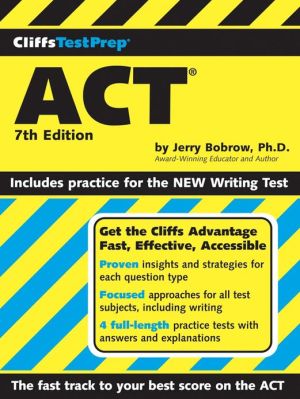
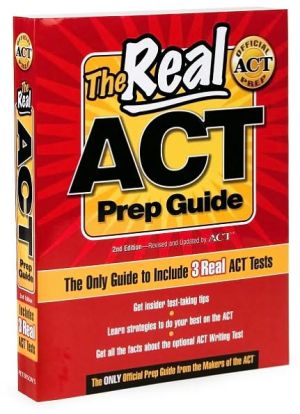
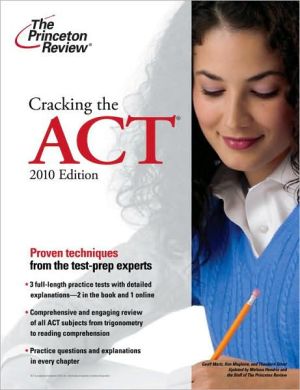
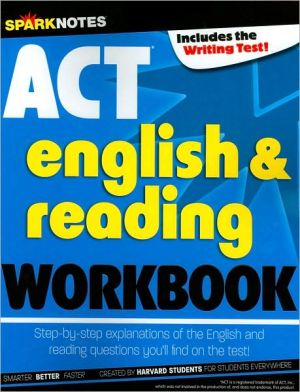
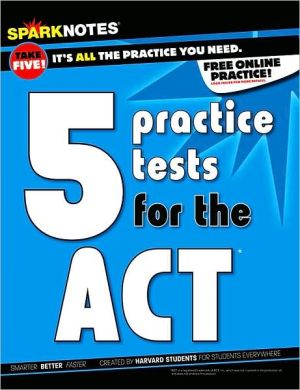
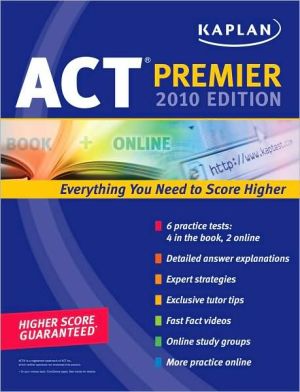
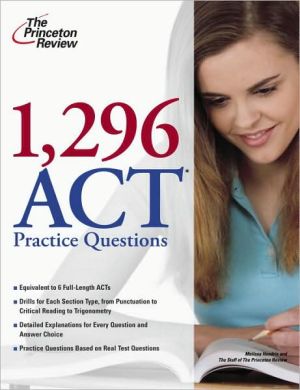
![The Real ACT Prep Guide [With CDROM] The Real ACT Prep Guide [With CDROM]](/application/data/covers/14/02/9780768931402.jpg)
